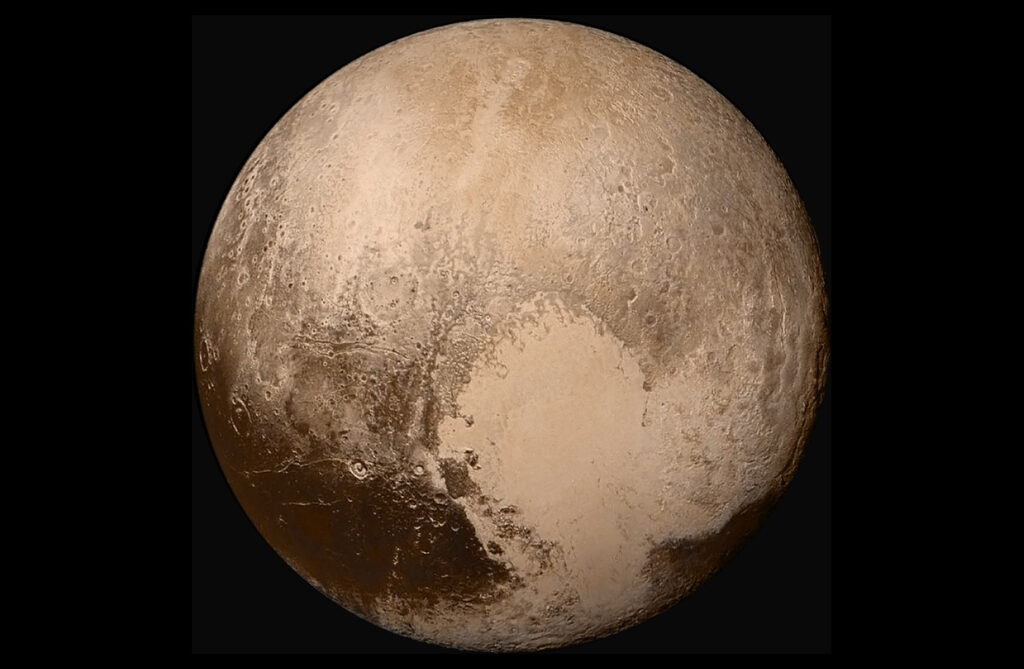(134340) Pluto was discovered on 18 February 1930 at the Lowell Observatory in Flagstaff, Arizona by comparing some of the celestial photographs of Clyde Tombaugh and was till 2006 the ninth and outermost planet in the solar system. The debate whether Pluto ever deserved the label “Planet”, started when beside his highly elliptical and highly inclined orbit also his small size was observed. After the third trans-Neptunian object was found in September 1992 astronomers discovered a year later within a few days four more remaining objects. This increased the debate about Pluto’s status. Over time, hundreds of other Kuiper belt objects were discovered, including some in Pluto comparable size. Eris was named after its discovery by the media often “Tenth Planet”. Nevertheless the IAU (International Astronomical Union) confirmed none of these numerous objects as a tenth planet. Instead the new class of dwarf planets was defined by the IAU in 2006 for such bodies and Pluto lost its status as a planet.

Till today very little is known of Pluto. It is known that he has a very eccentric orbit, which differs considerably from that of the other planets. So he crosses Neptune´s orbit, which means that there are times when Pluto is closer to the sun than Neptune. The last time this happened was from 1979 to 1999.
Pluto needs for a solar circumnavigation 247.68 years. Compared to the other planets, Pluto´s orbit is much more eccentric, with a numerical eccentricity of 0.2488. This means, the distance to the sun is up to 24.88% smaller or larger than the semi-major axis. However, the shape of the path differs by less than 3.2% on a circle. Pluto rotates in 6.387 days once around its own axis. The equatorial plane is inclined at 122.53° relative to the orbital plane, thus means that Pluto rotates declining. Its axis of rotation is thus even more inclined than that of Uranus. The reason for Pluto rather large rotation period is the tidal forces of his very large moon Charon. So Pluto and Charon are the only known bodies in the solar system with a double-bonded rotation.
For an observer on Pluto the apparent diameter of the sun would be only about 1/50 of the apparent solar diameter, we perceive in on Earth. The sun would look for an observer more like a star – but an extremely bright star, because he illuminates Pluto 164 times as strong as the full moon the Earth.
Pluto has five known moons: Charon, Nix, Hydra, Kerberos and Styx. Their orbits are nearly circular and coplanar with each other. They are not in Pluto’s equatorial plane but in its orbital plane.
On 19 January 2006, the New Horizons probe of the NASA launched to Pluto and passed Pluto and Charon, after about 9.5 years of flight time, on 14 July 2015. New Horizons was the first spacecraft visiting Pluto. Two weeks after the closest approach the observations of Pluto and its moons was terminated, and the probe began to transmit the during the passage collected data to Earth. As the transfer rate over this distance is very small, a few months will pass before all data arrive on Earth.
| Discovery date | 1930 (Clyde Tombaugh) |
| Semi-major axis | 5 906 423 103 km = 5.906 x 109 km (39.482 AU) Comparison: 39.482 x Earth |
| Perihelion | 4 436 773 628 km = 4.436 x 109 km (29.658 AU) Comparison: 29.658 x Earth |
| Aphelion | 7 375 922 980 km = 7.375 x 109 km (49.305 AU) Comparison: 49.305 x Earth |
| Diameter | 2370 km = 2.370 x 103 km Comparison: 0.1874 x Earth |
| Mass | 13 030 000 000 000 000 000 000 kg = 1.303 × 1022 kg Comparison: 0.00218 x Earth |
| Density | 1.869 g/cm3 Comparison: 0.3173 x Earth |
| Escape velocity | 4356 km/h = 1201 m/s Comparison: 0.108 x Earth |
| Sidereal rotation period | 6.387 Earth days 153.29 hours |
| Orbital period (Length of a year) |
247.343 Earth years 90 280 Earth days |
| Average orbital speed | 16 812 km/h = 4670 m/s Comparison: 0.1568 x Earth |
| Eccentricity | 0.2488 Comparison: 14.89 x Earth |
| Inclination | 17.16° |
| Axial tilt | 122.53° Comparison: 5.225 x Earth |
| Minimum/Maximum surface temperature |
-240/-218 °C = 33/55 K Comparison: The temperature of the Earth is ~ 185/331 K |
| Composition of the atmosphere |
Nitrogen (N2), Carbon monoxide (CO), Methan (CH4) Comparison: The atmosphere of the Earth is mainly composed of N2 and O2. |
Moons:
Pluto has 5 known moons.